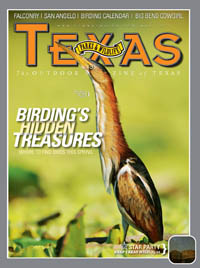
Flora Fact: Don’t Squish the Caterpillars
Flame acanthus puts out a welcoming feast for hummers and butterflies.
By Sheryl Smith-Rodgers
The first time caterpillars swarmed our flame acanthus, my husband snipped off the infected branch and relocated it elsewhere. A few weeks later, when more appeared, I kept mum and thumbed through a field guide.
Suffice it to say that the second brood stayed. Because I’d learned that our black-bristled, light-blue larvae would soon transform into crimson patch (Chlosyne janais) butterflies. Minus a small bare area, the bushy acanthus survived fine.
That’s nature at work! In the wild, flame acanthus — also commonly called hummingbird bush — occurs from northern Mexico into West Texas and the Edwards Plateau. It grows as tall as 5 to 6 feet on rocky stream banks and in grasslands. Available in commercial nurseries, the native perennial adapts well in home landscapes and can overwhelm neighboring plants with its full, leafy branches. Plus, it’s known to reseed with enthusiasm.
Factoid: Each pod produces two seeds and catapults them away using a hook-like filament called a jaculator.
From summer into fall, flame acanthus turn orangey-red with trumpet-like flowers that attract hummingbirds and butterflies. The drought-tolerant species may also host the larvae of common buckeyes (Junonia coenia) and Texas crescents (Anthanassa texana). So, please don’t squish those caterpillars!

